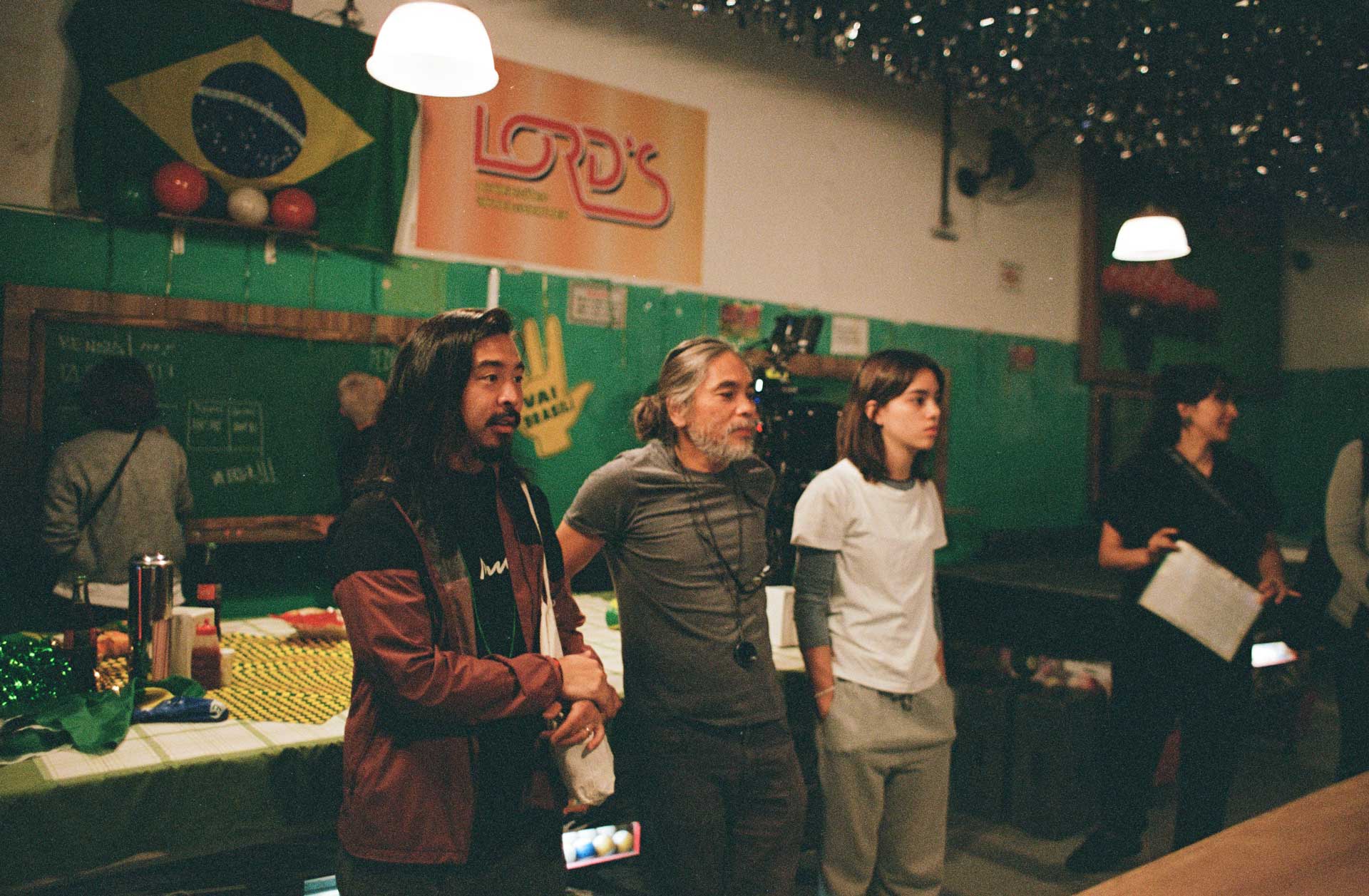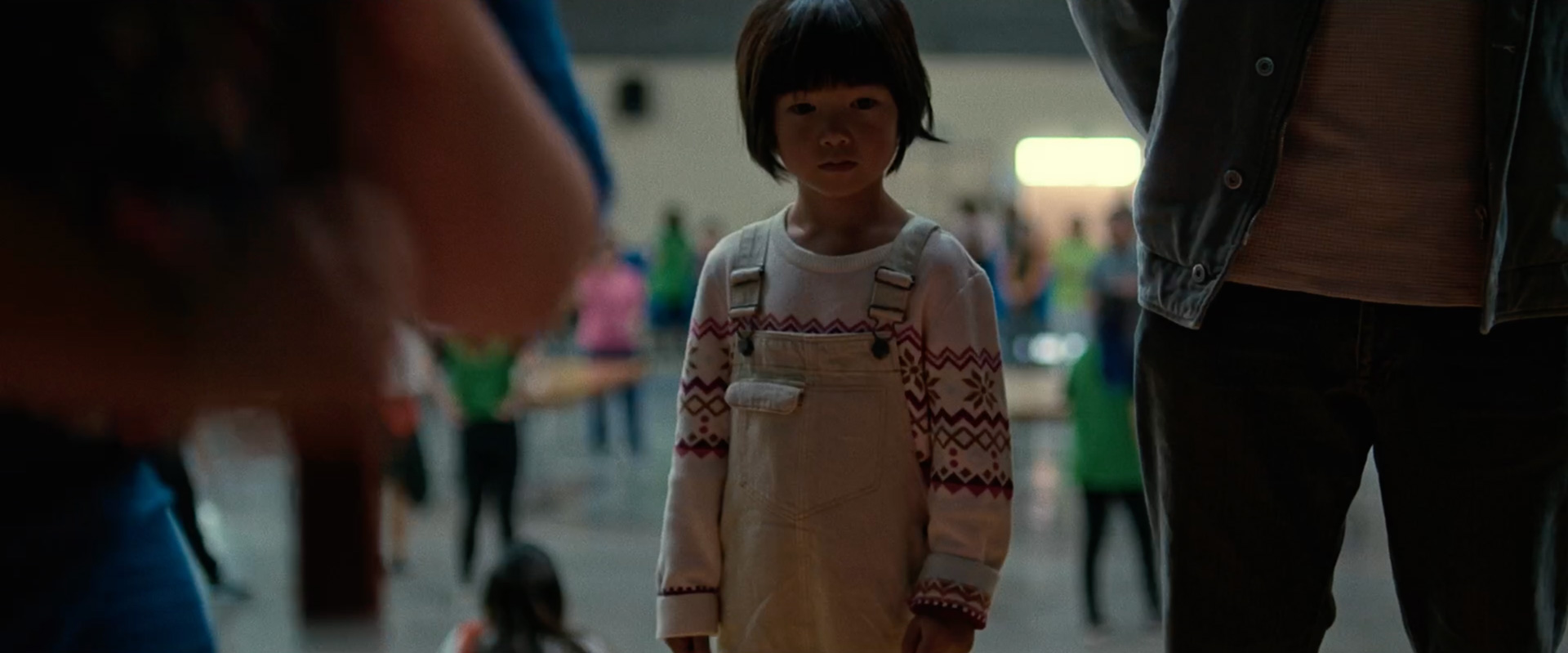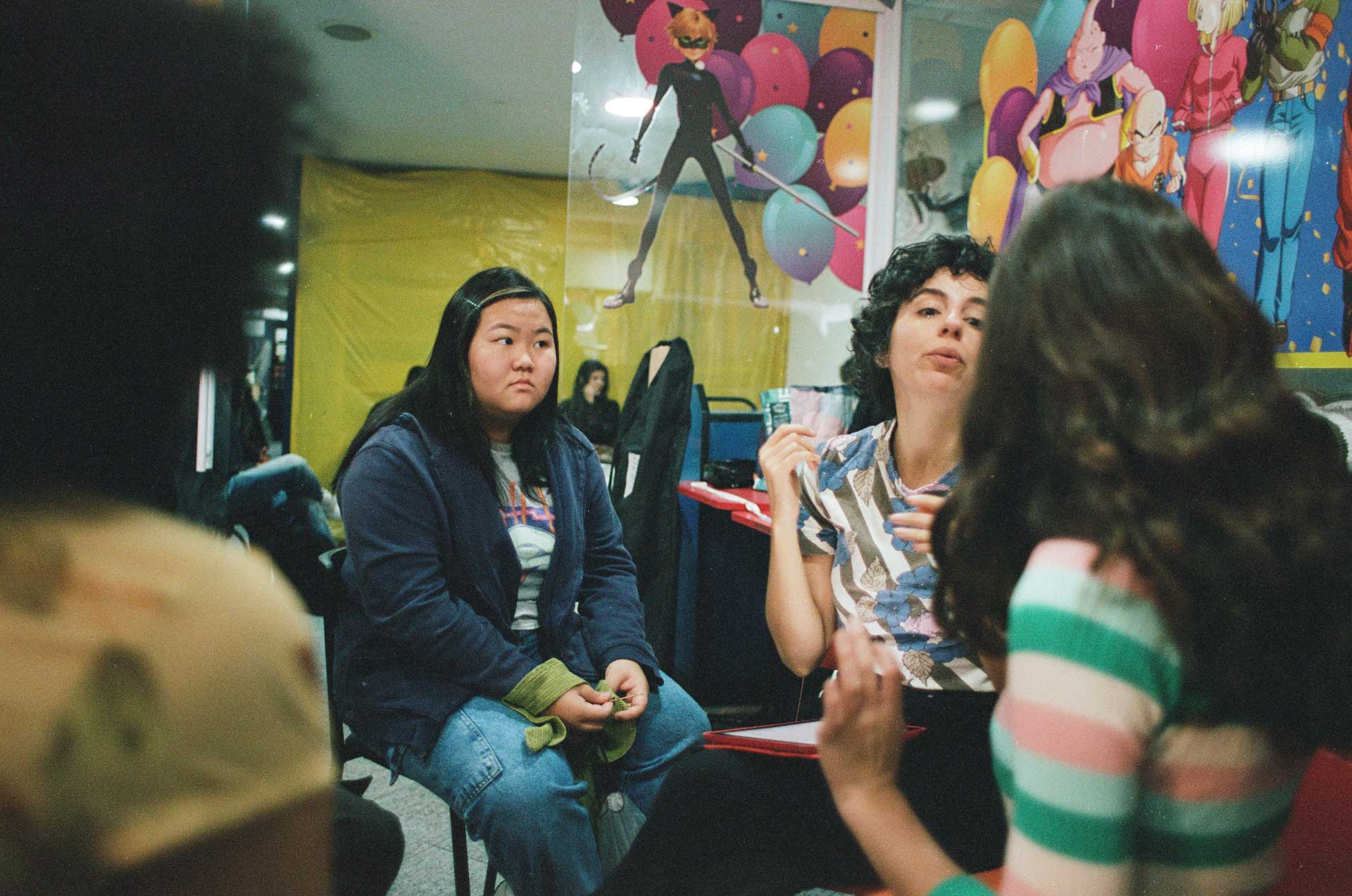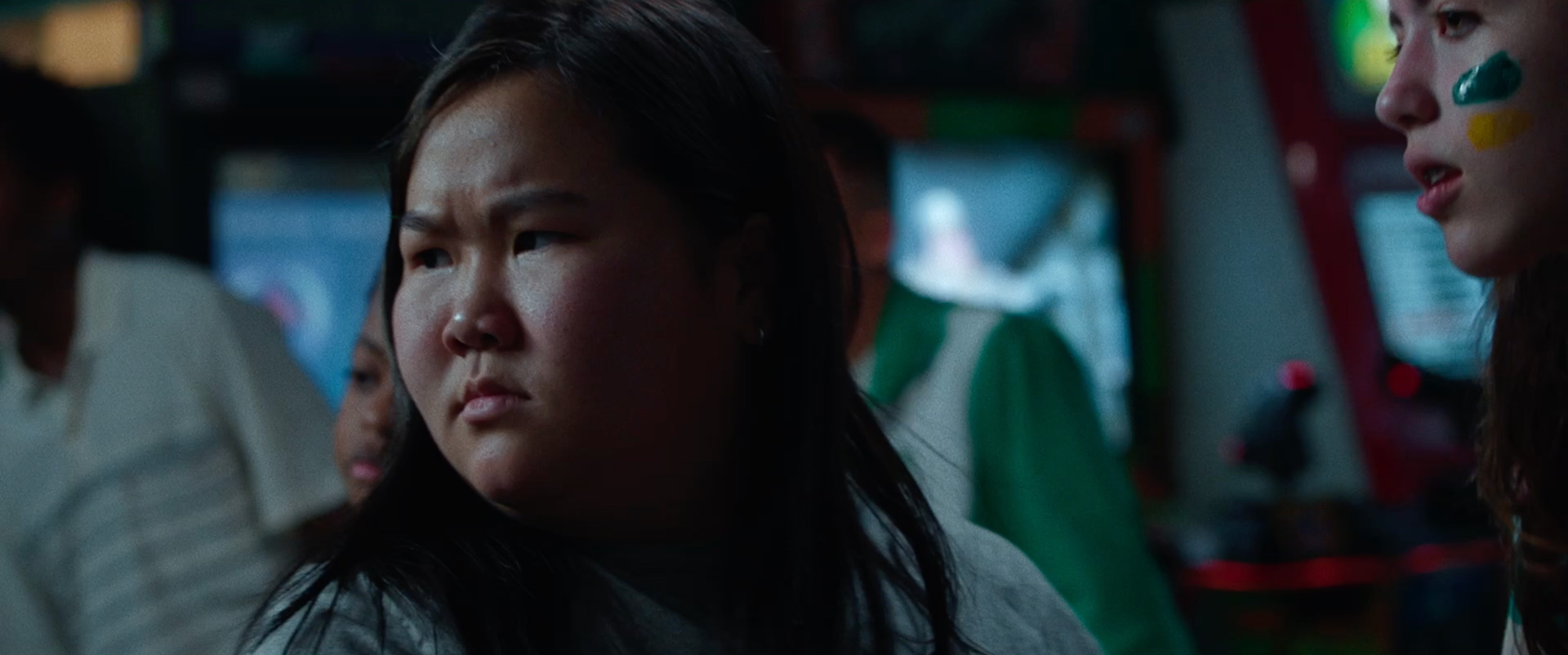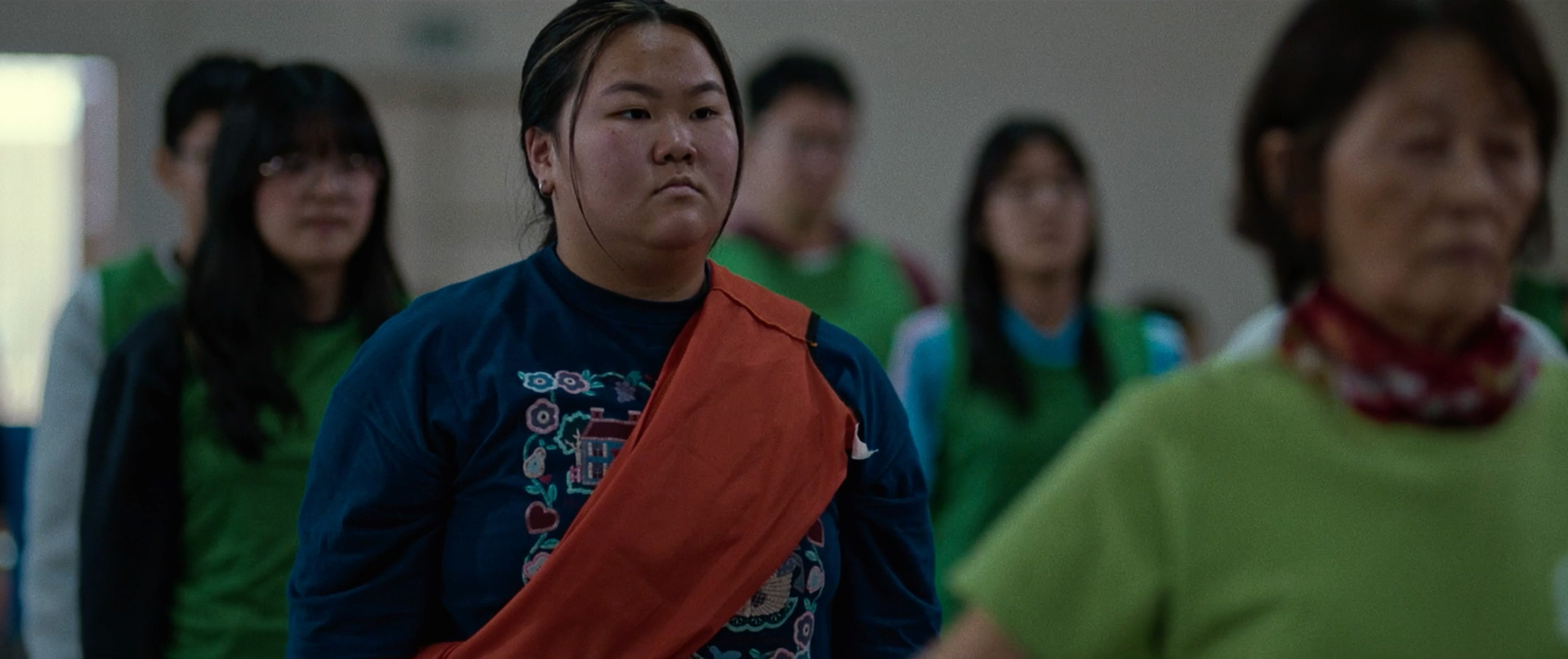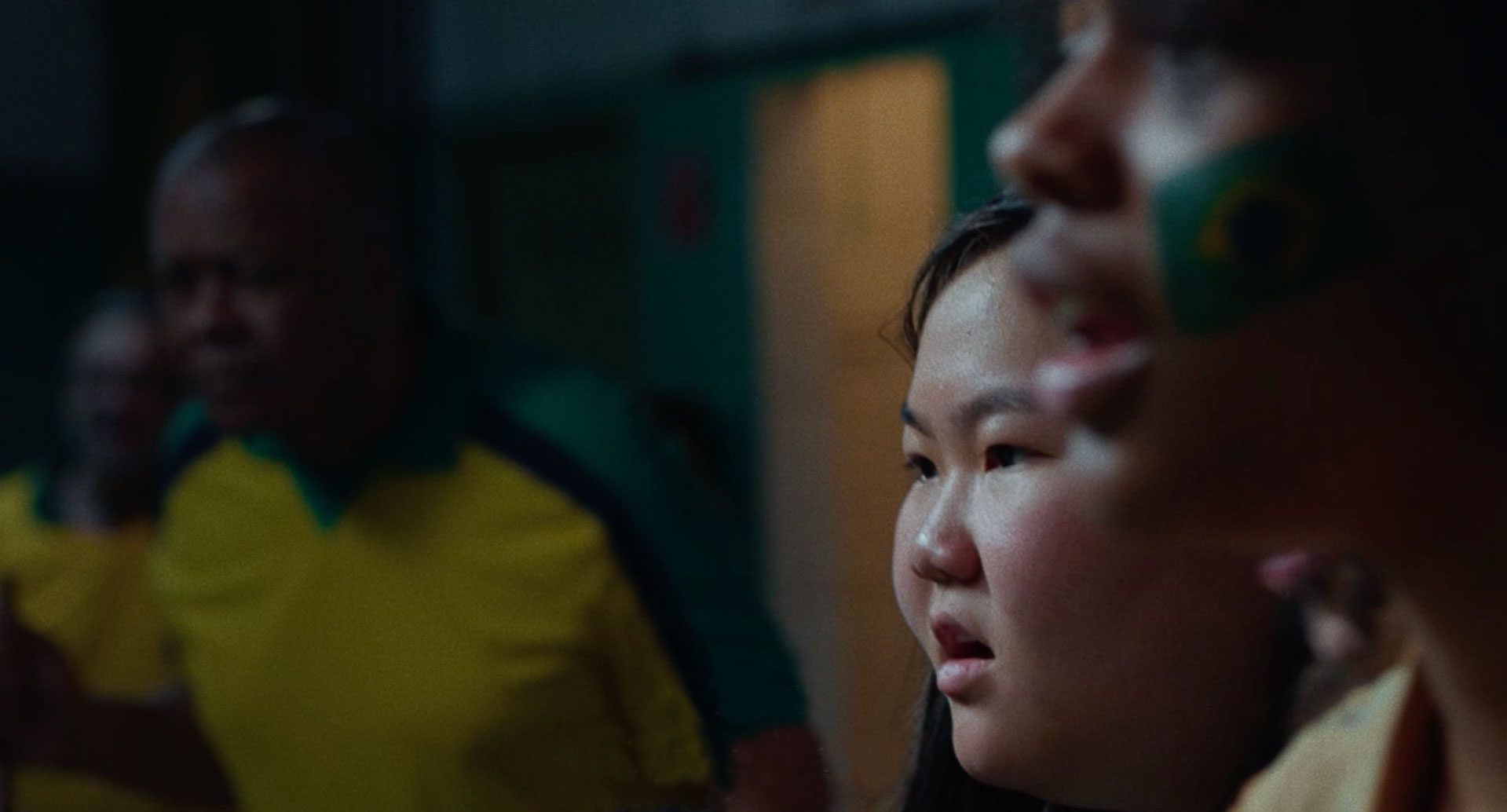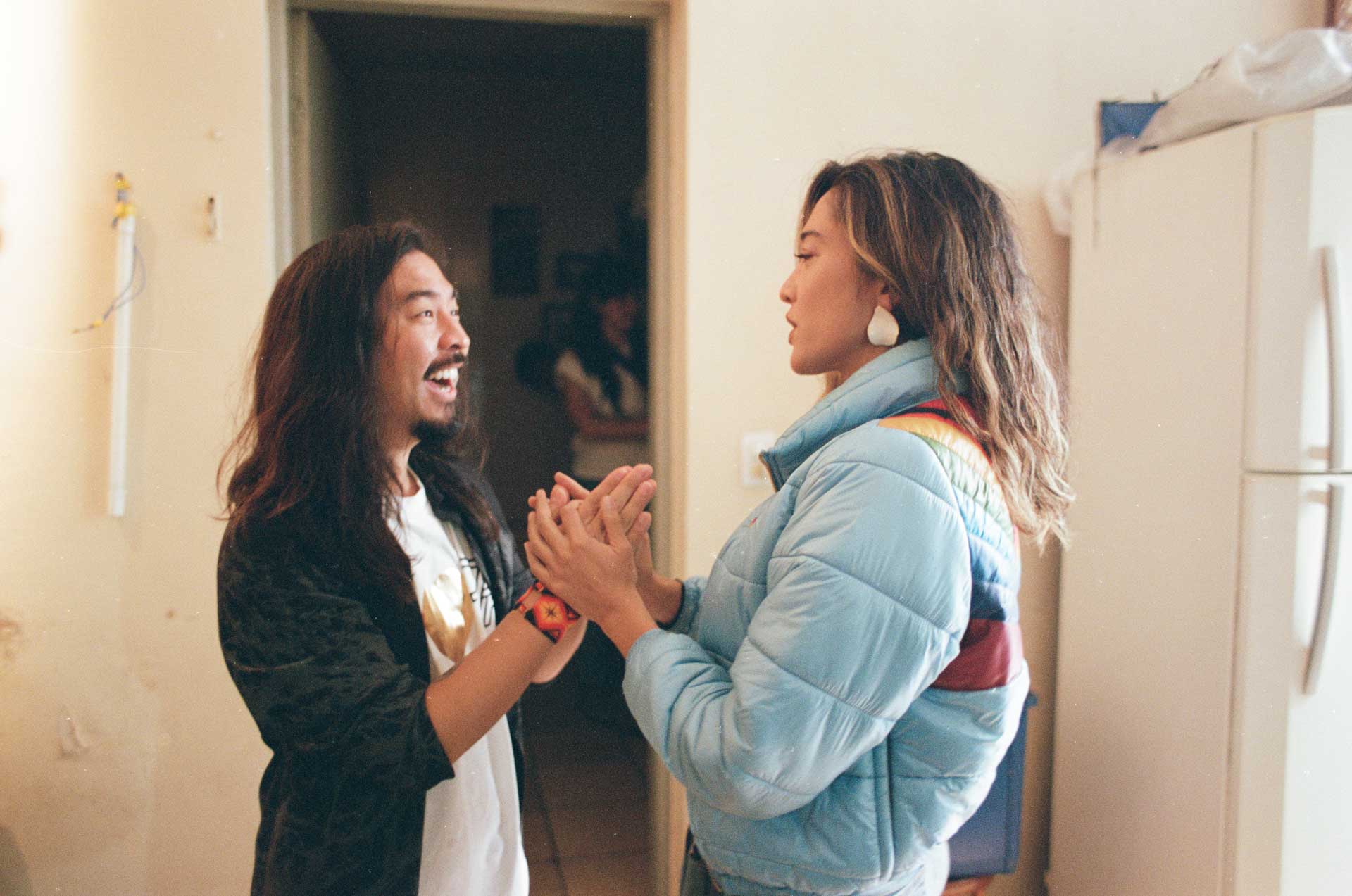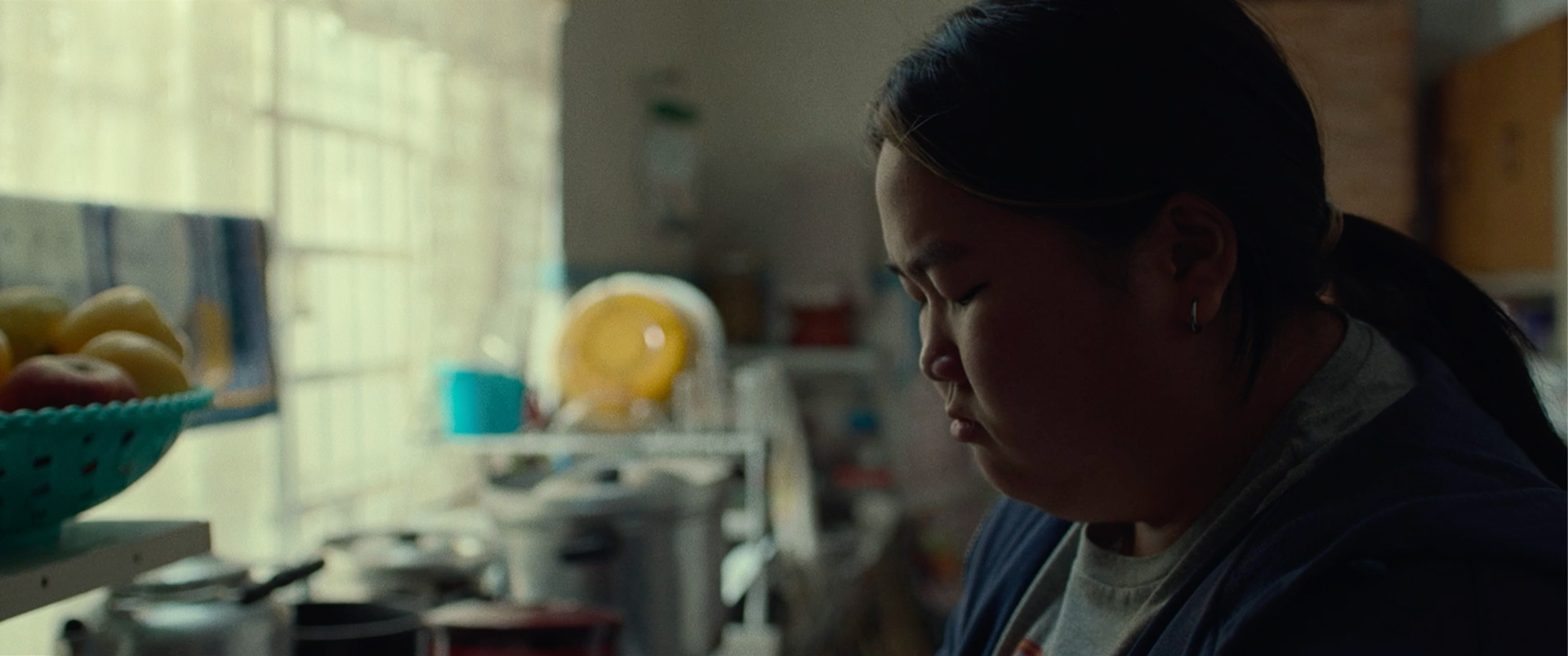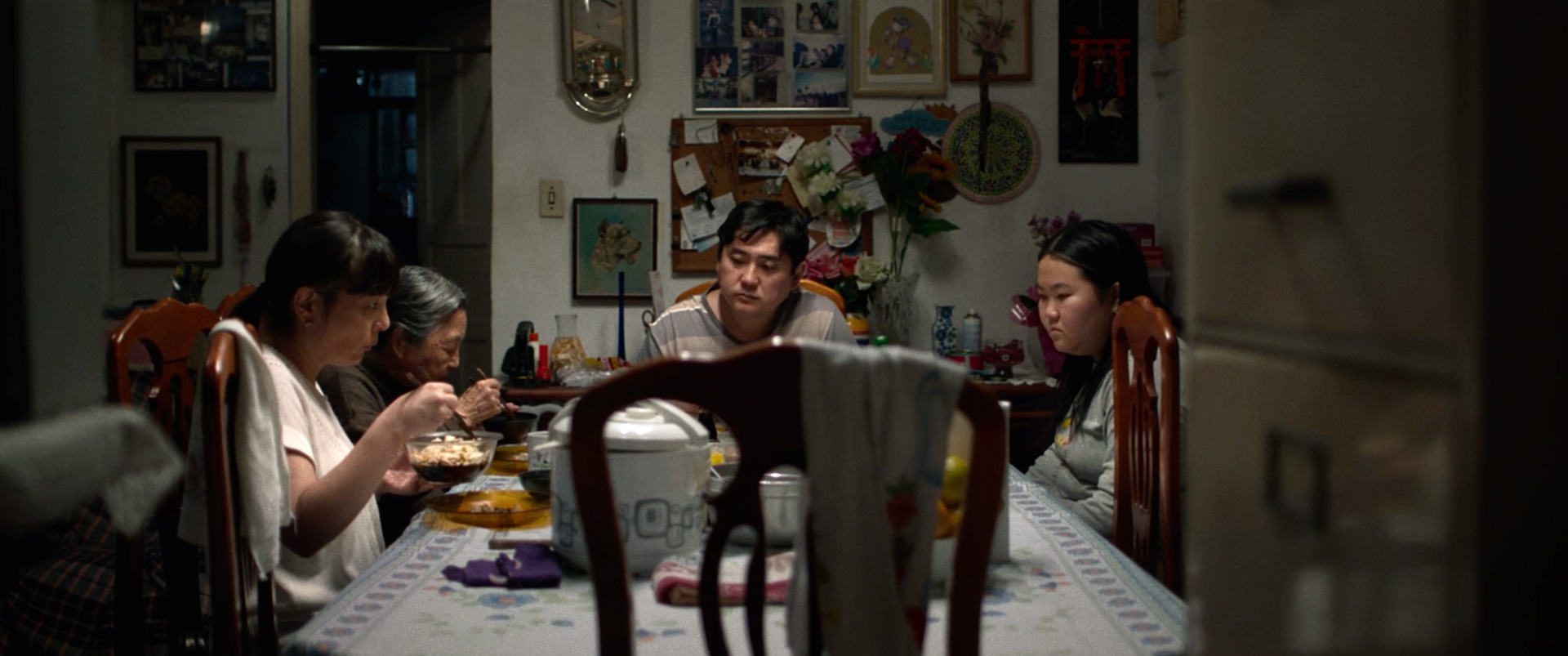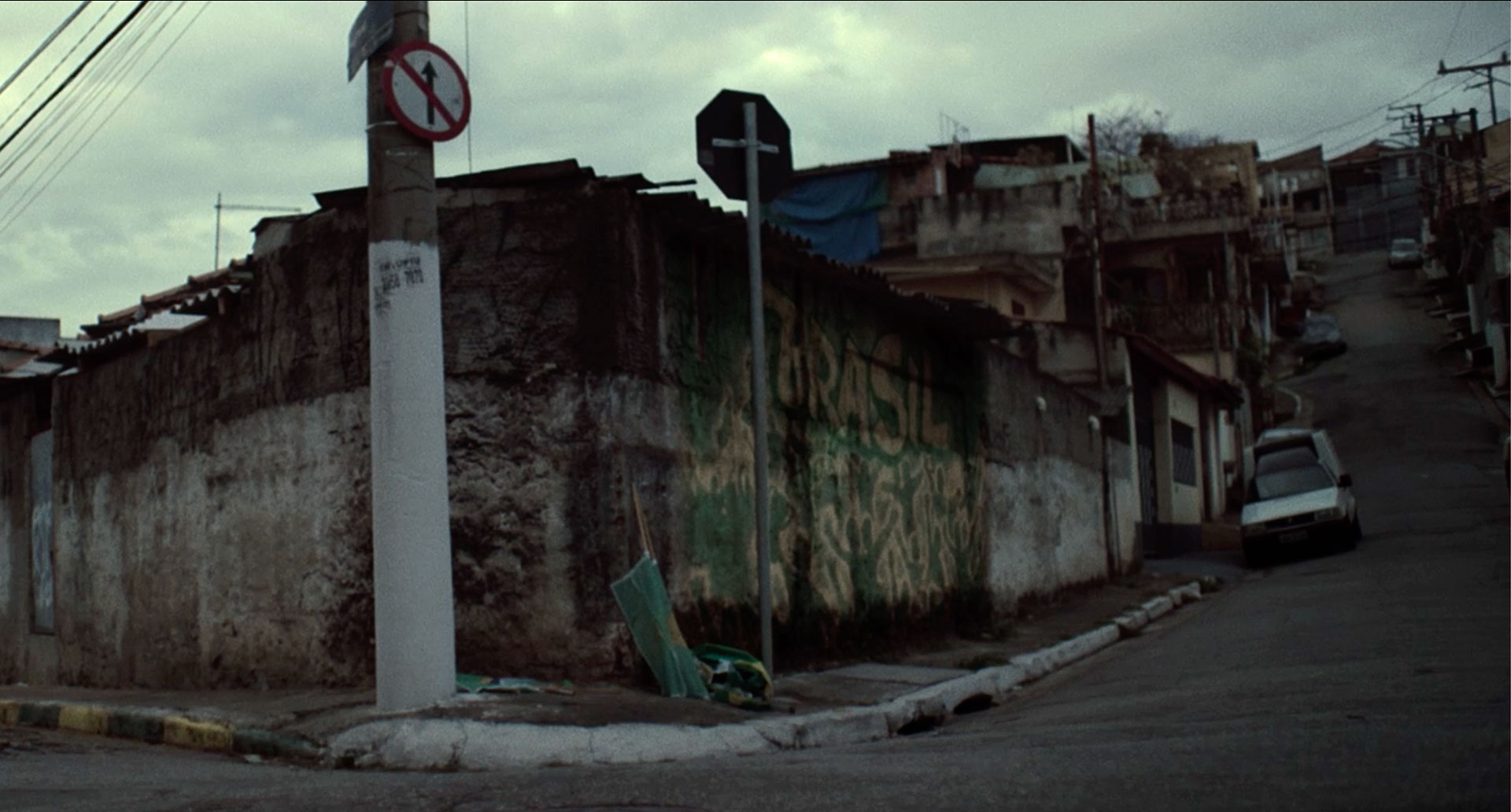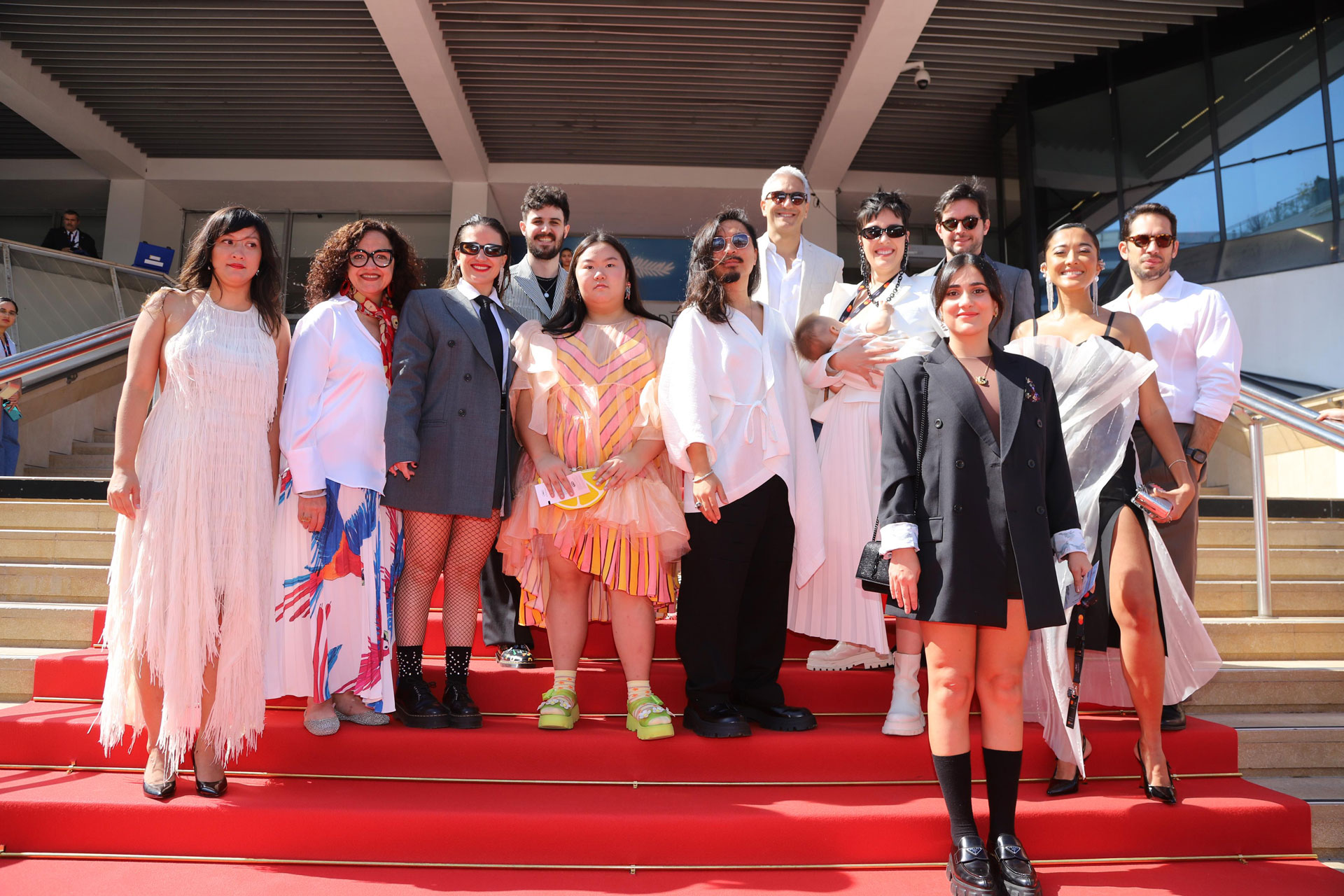MA: Yes, we met seven years ago when you had a feature film script you were going to direct with another director. You had written it together, and when you told me the story, I found it beautiful. I think your filmmaking is deeply rooted in your life experiences and encounters, which is also the kind of cinema I believe in—purposeful, where we can explore peculiarities and truly express our viewpoints.
AHS: A quick note about that meeting and the idea of stories that come from a personal and deep place, what I like about our partnership is how we’ve been shaping both direction and production together. There’s a lot of talk about the director’s vision, but there’s always someone producing that vision. I see us developing a combined direction/production style, a way we like to produce and tell stories. That’s what brought us to “Amarela,” our short film that was nominated for the Palme d’Or at Cannes this year. And going forward, we’re hand in hand, crafting the stories we want to tell. Of course, as a producer, you work with many other creators, and each collaboration brings a different approach, but we’ve been working on personal stories with a very artisanal, careful, and intimate production style.
MA: Intimate! That’s an important word because we’ve created a bond. Amarela didn’t take seven years to film, but the process took seven years. Speaking of the process, one thing I often challenge creators with… You had this personal story about an encounter with a special child during a trip to India. The script was beautiful, and I think it will still be made in some form. But from there, it started provoking other feelings. The realization of why you wanted to tell that story came from this exploration of how you were trying to communicate it. The story was about a boy who, at a young age, was already making films. You met, connected, and when we brought it to a personal level, I think you began to see yourself in that boy.
AHS: Yes, because this 12-year-old boy had a dream of making films, of expressing himself. I actually met him when he was eight, and he had such a powerful look, a strong way of expressing himself, and a message ready to burst out. I saw a lot of myself in him.
MA: I think the first challenge, the seed of everything, was reflecting on our position in portraying this Indian child, right? We’re always concerned with how we represent the people we’re talking about. And with that awareness, we realized he wouldn’t be Indian, but Japanese-Brazilian.
AHS: That’s interesting because, as a Japanese descendant, I’ve gone through a lot related to that identity. When we started writing a script in 2020, which we hope will be my first feature film, called ““Crisântemo Amarelo”, you suggested bringing in a screenwriter. That is when we brought Eri Sarmê in, a screenwriter and also a director. He was incredibly generous in the writing process because he embraced a lot of my personal history. When you joined the project, a few years before, the script wasn’t moving forward. My partner and I were feeling stuck.
MBA: You both had important perspectives, really great ones. And you were both empathetic to each other’s views. It was you and Cesar Nery, who also works with us here at MyMama and still partners with you on commercial projects. But you’re quite different. César would suggest something, and you’d understand and appreciate it, but it wasn’t necessarily what you envisioned for your first feature. I think I really pushed you both to see this project as an opportunity to find each of your voices in cinema. Through that, we realized you had two beautiful but very different viewpoints.
AHS: Exactly. And that’s why the script wasn’t progressing. In auteur cinema, there’s always a strong perspective, a worldview. It can be done in partnerships, but in this case, it wasn’t working. When you suggested bringing in an outside screenwriter and letting one person lead the decisions, things started to flow. It really took shape when I began working with Eri Sarmet in 2020. It was at the beginning of the pandemic, in March, so it was tough. We had long creative sessions, lasting three or four hours every week.
MA: And by then, I was already living by the beach.
AHS: That’s right. And I remember you raised this idea: What if the boy was Black instead of Indian?
MA: I was trying to bring a Brazilian identity into the story, trying to ground it in Brazil.
AHS: Yes, we were trying to move away from India or a non-specific location. But it still wasn’t quite right. Then you suggested: What if he’s Japanese-Brazilian? That hit me hard. I had to let that idea sink in for a few days.
André Hayato Saito, Hélcio Nagamine e Kadu Oliveira, during the filming of “Amarela”. São Paulo, 2023. Photo: Danilo Arenas.
Luana Demange, during the filming of “Amarela”. São Paulo, 2023. Photo: Danilo Arenas.
MA: It’s such an interesting culture. It was a discovery for me. Now, I’m trying to get adopted by your family [laughs].
AHS: [Laughs] That really struck me. I hadn’t considered the possibility of making an openly Japanese-Brazilian story or telling the story of the Asian-Brazilian community. After months of creative work, we decided that “Crisântemo Amarelo” would be the story of a 14-year-old Japanese-Brazilian girl named Erika.
MA: I think the choice of making the character a girl came from the fact that the script was starting to feel a bit autobiographical, right? If the character were white, regardless of gender, no one would associate it too much with being autobiographical. But since there was this Japanese-Brazilian aspect, it led people to think it was completely autobiographical.
AHS: I hadn’t thought about that.
MA: I felt that when we made the character a girl, it gave you more freedom. When the character was a boy, it seemed more anguishing for you.
AHS: That’s interesting. I really didn’t want it to be autobiographical. It was never about that. I want to tell a story and, of course, include things that affect me deeply, but I didn’t want it to be my story.
MA: That’s why I see the girl as the key point for creating that distance we were able to achieve. Funny that we never talked about this before.
AHS: Your perspective is interesting. If it had been a white boy, we wouldn’t have had this issue.
MA: Yes, because there is a subtle but real prejudice against Asians. It has its nuances, but there is no doubt it exists and it’s very much present. In the first short films we produced together, (“Kokoro to Kokoro” e “Vento Dourado”), were documentaries, but also fictional—a mix of both, but only with Japanese-Brazilian characters. And with that, when we sent a film to people who weren’t from Brazil, they understood it as a Japanese film.
AHS: That’s true, isn’t it? And it’s funny because even though the characters were speaking Portuguese, like in “Vento Dourado”, people still called it a Japanese film.
MA: It’s strange because you also have to find your place in this, right? When you submit a film to a festival, the programmers select films that represent the countries they come from. When they receive a Brazilian film, they have certain expectations, and our films didn’t fit into those expectations of what a Brazilian film should be. It was a challenge until we found festivals that could recognize that.
AHS: Indeed! It’s such a deep conversation, and it’s great to bring it here to Art Dialogues, talking about artistic processes. Because the image is so strong and powerful. The phenotype that an Asian, a yellow-skinned person in Brazil, carries so many stories, narratives, and prejudices.
Alice Saori, still image from “Amarela”. São Paulo, 2023. Cortesia: MyMama Entertainment.
MA: It’s crazy because the focus of this trilogy isn’t solely on the Japanese-Brazilian community. We were telling the story of these characters, living their lives. These are films with many layers, exploring the space between life and death, and that didn’t fit into what festivals typically expect from Brazilian cinema.
AHS: But it’s interesting how, for example, setting “Amarela” during the World Cup final in Brazil was an unconscious way of appealing to that. Like, I’m talking about Brazil zil zil. It’s a shout. When will they recognize me as Brazilian? And sometimes we find ourselves having the same kind of prejudice or limited view about other nationalities.
MA: Yes, and what does it mean to be Brazilian, right?
AHS: Exactly. If you think of a Swedish film, you’ll probably immediately picture white Swedish people, not the Afro-Swedish community. And I think “Amarela” brings a bit of this value of broadening our vision of what we imagine about nationalities.
MA: Yes… Even with gender issues. We talk a lot about how you present yourself, how you express yourself, how you feel. And that’s obviously important. But it’s also about how people see you, right? That’s why the place of speech is important. For example, I come from a Lebanese family. My grandfather fled the war and came here by boat, with no money. That classic story: he came as a minor trying to start a life in Brazil. So, I’m also part of the diaspora. But I don’t appear as such, so…
AHS: The phenotype “at first glance” isn’t that striking. But actually, upon closer inspection, it’s quite distinctive as well…
MA: Yes, Brazil is very mixed.
AHS: That’s why this context becomes so interesting when situated in Brazil. We’re in a country with a lot of cultural and phenotypic mixing, right?
MA: Exactly. And, just to wrap up this chapter, the feature film found its protagonist in this Japanese-Brazilian girl we call Erika. And with that, you were able to develop the story with much more personality, paying attention to the small details. Like, it’s Feijoada with Gohan, right? It’s also visual. We’ve been working on the feature film that originated “Amarela” for four and a half years, maturing the script, presenting it at markets and labs. We took it to Cannes, Toronto, to Berlinale Talents, it was selected for a lab with Apichatpong [Weerasethakul]. It’s a project that was already gaining momentum. But a feature film is a long process, requiring a lot of patience. It’s part of the story’s maturity too, like the gestation of a child or waiting for an adoption. Sometimes that time is necessary for you to settle in and prepare.
AHS: It’s not some sudden outburst that appears. It’s usually a long gestation because it’s a collective, artisanal process. And it takes time compared to shorts, commercials, or music videos, right?
MA: Yes, your project has to be really strong to secure funding. That forces you to take many “no’s,” and those “no’s” are actually very stimulating to find your “yes’s.” It doesn’t mean your project is bad, but it gives you the opportunity to really look at yourself, at the project, and understand: okay, what do I have here? It’s a constant provocation. And I think art is meant to provoke. Our process ends up being provocative, despite being super bureaucratic because we have to write proposals, apply for grants, sign contracts, and so on. You have to want it a lot to make films, right? That’s why I think it’s worth you talking a bit about your eagerness to make “Amarela.”
Upper image: Melissa Uehara and Marina Medeiros. Left and right center: ACREC’s cooks, lower image: Joana Amaral, Lorena Castro and Bernardo Antonio.
Making of “Amarela”, São Paulo, 2023. Photo: Danilo Arenas.
AS: Last year (2023), my wife, Tati Wan, joined as co-writer and co-producer of “Amarela” – she had already worked with us on the previous two short films. She was pregnant, and we had a baby due in September. In March, I called you and said: I need to make a 100% fiction short film before the feature. Since the previous two shorts were fictional documentaries, that idea stuck in my head, like an obsession. And because time was tight, I wasn’t going to write a script from scratch. My proposal was to take the main character from the feature, which we had already been developing.
MA: A character we had been building for almost four years.
AHS: Exactly. Nowadays, we call it a proof of concept. So, it’s a prototype, a rehearsal for the feature film. But I really felt the need to make a 100% fiction short film and find this girl. Whether it served the feature or not, whether the character worked or not, it would be a test for us to see the potential of the story and what would work. And, obviously, when we dive into artistic processes of telling our pains, traumas, and embedding fictional narratives with the messages we want to convey to the world, it always comes wrapped in a lot of questioning, doubt, fear, and the urge to give up. Because it’s hard to make films in Brazil, and anywhere else. So, you ask yourself: Is this really interesting? Will anyone like it? Will only the Japanese community like it? Will only the Brazilian Asian community like it? Is it a universal theme? So, I felt the need to test it, and with that, we worked like crazy. I presented the project to many, many, many people and companies to get funding, support, and, well, in three months, we pulled it off.
MA: Which is a miracle because… And we had already invested so much of our own money in so many things. It was important to figure out how to get funding without investing ourselves again.
AHS: There was even a new grant open, and we applied.
MA: But you doubted if the grant would come through in time.
AHS: Yeah. And for me, it’s interesting that this urgency didn’t just come from wanting to produce an experiment before the feature, but also because I got it into my head that I wanted to make “Amarela” as a rite of passage into fatherhood, where I could immerse myself in the script, the direction, the production, presenting something to 1000 people before my son with Tati arrived. And we managed to do that in record time, even without getting the grant. So, it really was a miracle.
MA: You were set on not waiting. And I kept postponing, but the funding needed to come from somewhere. And you went out and got it. Only you could get people to believe and invest money in a short film because there’s no financial return for that.
AHS: It’s almost zero, really.
MA: And we didn’t know the short film would end up at Cannes, [laughs]! That wasn’t the goal. The goal was to create this proof of concept. Making films is a huge risk because we don’t yet have a strong audience base in Brazil… I’m talking more about the audiovisual, about cinema, but I see it as a broader issue for the arts in general, making art that brings financial return. So, distribution is a learning process for us. Thank God we have funding that enables cultural production, elevating this culture as something significant. However, there’s still a challenge in making it viable and ensuring it reaches people. It was incredibly important to see people lend a hand to André and to “Amarela”, believing in this story. By the way, I don’t think we’ve shared the short film’s story or synopsis yet, have we?
AHS: It’s the story of a 14-year-old Japanese-Brazilian girl on the day of the World Cup final. She rejects the Japanese family traditions at home, rejects her origins, and outside, she faces a lot of prejudice, this somewhat invisible racism, so to speak.
MA: There are two emblematic scenes. One is when she’s watching the World Cup with her friends, and a discussion about football starts, and a friend says: “Go back to Japan.” And it’s a really heavy moment. Another friend says something like: “you look cute cheering for Brazil”. And she is Brazilian, her family is Brazilian, but people only see her as Japanese. So, I think those are two important lines there.
AHS: I’ve heard that a lot during every World Cup. I still hear it, actually. People ask: “hey, but if Brazil played against Japan, who would you root for?
MA: Really?
AHS: Every World Cup. It’s insane.
MA: It’s like someone asking me if I’m going to cheer for Brazil or Lebanon.
AHS: Exactly [laughs]. So, “Amarela” is about this identity struggle. It’s very complex, especially for a child or teenager, to be labeled as something they don’t identify with. She doesn’t see herself as Japanese, Chinese, or Asian. But everyone labels her that way. And “Amarela” highlights this contrast between Japanese and Brazilian cultures, which are very different, not just in phenotype but in many other aspects.
Melissa Uehara, still images from “Amarela”, São Paulo, 2023. Courtesy of: MyMama Entertainment.
MA: And how did you go about selecting the crew for the short film?
AHS: I got it in my head that I wanted to gather as many Brazilian Asian people as possible for the crew. So, we ended up with a predominantly “yellow” (1) crew. In these 15 years of making films, I’ve never been on a set where I saw so many people who looked like me.
MA: I also have never seen a set like that one.
AHS: It brought a sense of belonging, which is something I’ve really sought throughout my life and have always found hard to come by. There’s a significant issue for the “yellow” community in Brazil, which is classic, and in my case, it’s: I feel too Japanese to be Brazilian and too Brazilian to be Japanese. So, this in-between identity often puts you in a situation where, whether as a teenager, a child, or even as an adult, it’s hard to feel like you belong because you’re neither here nor there. Until you realize that this middle ground, this border, is huge, and that between black and white, there are infinite colors. It was amazing to have been able to bring so many Asian people into the crew. And for the crew members, it was also something very powerful because I think everyone embraced the story as a pent-up cry. Something like: “Wow, I never see myself represented, and when I do, it’s always in a very stereotypical or fetishized way.” Seeing Asian female characters hypersexualized and male characters desexualized is very common. There’s still this issue of Asian women being the most searched on porn sites in Brazil. So, there’s this place of submission, the stereotype, the fetishization, or the desexualization. The way the Asian body is seen is very complex. So, the feeling that we were telling OUR own story was something profound for everyone there. And how rare that is!
MA: It was beautiful. And there was such a strong sense of unity that was incredible to witness. We don’t think much about this kind of representation, right? We tend to call people we’re used to working with, but we need to pay attention and always talk about whiteness. You opened the set by saying everyone’s full name, as a tribute to the ancestors, and everyone was so emotional. It was because they felt part of something, not because they were placed in a designated, stereotyped spot, but because they were simply doing their regular job. It’s a film set, and you’re doing your work, but with people who you can identify with and who understand what it’s like to be an Asian Brazilian, right? And it’s funny because there are so many stereotypes about Brazilians too, but there is a cultural difference. I remember your father saying yesterday when I had lunch with your family, in such a beautiful way, about how you don’t complain about food, whether it’s good or bad.
AHS: That was an interesting point.
MA: He was saying it wasn’t his place to comment on that. It reminded me of something else you say, which I find curious, that in Asian culture, especially Japanese, the one who speaks less wins.
AHS: Yeah, there’s a lot of that. The unsaid and silence are very powerful elements.
Upper image: André Hayato Saito and Jacqueline Sato. Central image: Gabriela Akashi and Hélcio Nagamine. Lower left image: Tati Wan, André Hayato Saito, and Hélcio Nagamine. Lower right image: Melissa Uehara, Tati Wan, André Hayato Saito, and Mima Mizukami.
Making of “Amarela”, São Paulo, 2023. Photo: Danilo Arenas.
MA: And in Amarela, we see this character expressing herself with so much strength, right? That was something we heard a lot at the Cannes Festival… Everyone was really captivated by the film, by you, and by our lead actress, Melissa, and how powerful she is on screen. The other day, I went to Tomie Ohtake, and there was an exhibition on Asian diasporas… I think I saw two different exhibitions, one on ceramics and another on painting, and you could see how the cultures blend. Maybe if it were only Asian, it wouldn’t have the perspective that Brazil brings and vice-versa. I also went to the Venice Biennale this year, where the theme was about diasporas, and it was truly a moving experience. I cried a lot. You’d enter each pavilion dedicated to different ones and live through that perspective. And entering these diasporas is a bit like what we feel when we watch Amarela. Because you physically feel like you’re entering that space and seeing that community, that art. As a producer, I had more access than the viewer because I was physically inside that world, with that team.
AHS: And inside that location. We filmed in the house across from the one where I lived in, Jardim Sônia in São Paulo’s North Zone for 25 years of my life. We went through a cool process of location scouting, and they were all those classic houses in Lapa, Ipiranga—places where many short films and series are shot. But I said, “This is not it!” Then Luana Kawamura Demange, our art director, said: “Saito, you need to go to reality, find where these people are.” I ended up reconnecting, after 15 years, with people from my street, old neighbors who are still there, running the same shops. We filmed inside those houses, and it brought so much authenticity. It wasn’t just a set with placed objects; it was our world.
MA: It’s curious because we both come from the North Zone. It’s a large area, and there’s also a significant Arab community there. My grandfather started as a helper in a small general store, which was very common among Arabs, and later, he had his own shop. And under the house we used as our location, there was also a small shop selling everything, right? It’s a very North Zone thing, a bazaar with thousands of items. It’s funny because the North Zone really does feel like another city, doesn’t it?
AHS: Yes, I think there’s even some pride from those who live in the North Zone.
MA: People see it as a large suburb, but in fact, a huge portion of São Paulo’s diasporic communities live there. When I entered that place, I also felt at home because I grew up around there. I think this brings us back to where we started our conversation, which is about giving people the chance to see different perspectives. Otherwise, every piece of art would be the same. Everything we see, everything we live becomes a reference. What’s most beautiful about what we do, and what we seek in our cinema, is discovering new stories, new perspectives, and new ways of seeing. You can make these discoveries even through a wild sci-fi story because those characters, those ideas, are built from many feelings, right?
AHS: That story about the bazaar was very interesting because, in Japanese families, it’s quite common for there not to be a division between the workspace and the home. You live where you work, and you work where you live. Our protagonist, Erika, is somewhat in that context because the film is set in 1998, and in the 90s, it was very common for Japanese-Brazilians to start working in small shops, bazaars, and mini-markets from a very young age. There’s a deep devotion to work, which is strong in Asian culture in general. With this exploration of my Japanese ancestry and yellow identity in Brazil, we began to see these short films as a trilogy. After two semi-documentary, semi-fictional shorts that people viewed as Japanese films, “Amarela” came with the force of finally confronting and clashing Brazilian and Japanese culture.
MA: A colleague of mine, Ilda Santiago, director of the Rio Festival and an associate producer of those shorts, commented that in the first two, you were searching for your ancestry, like a Brazilian trying to find yourself in that Japanese space. In Amarela, you turn back toward Brazil.
AHS: Exactly. I often say that with “Kokoro to Kokoro”, the first one, I filmed in Japan, so I was deep in the cave of my roots. In “O Vento Dourado”, the second in this trilogy, it was already different. I filmed with my family in a countryside house in Curitiba.
MA: That one, by the way, just played at Kinoforum.
AHS: Oh, yeah! The São Paulo International Short Film Festival is amazing! I saw many films there. That festival shaped a lot of my cinematic vision. And “Amarela” will have its North American premiere at TIFF in Toronto this September.
MA: And in Brazil, we hope to premiere it at the Rio Festival. When the film premieres in the Official Competition at Cannes, it opens many doors, which is incredible. The premieres of “O Vento Dourado” and “Amarela” were sort of together. We started with “O Vento Dourado” in the Moscow’s 46 Cinema Festival, then at the 31 Sheffield Doc Fest, and then it was shown in 20 FEST: New Directors, New Films, in Portugal. So, it’s running parallel to Amarela, and they really converse with each other. We also want to do a screening here in São Paulo at Sato Cinema, in Liberdade, which is often visited by the Asian community, showcasing all three films. But I should remind the reader that you have other works beyond these three [laughs].
AHS: I think this brings us back to our dynamic as a duo, as a team. Making these three films together feels like a natural part of the journey leading to the feature film.
MA: It’s truly a joint effort. And I think it’s beautiful how much space you always give me as a producer. I’ve worked as a producer with some creators, and some value it, while others don’t. But it’s a collaborative effort, and it has to be worthwhile for both sides. So, it’s also a relationship. Art alone is much harder. I could say I’m going to hire a director, a writer, and create whatever, but it wouldn’t have the same vision that our partnership brings. Similarly, you could say you’ll do everything on your own. You raised the money for Amarela, you went to Japan alone. But we’ve gotten to where we are because of the influence of both of us.
AHS: Combining these strengths.
MA: I really encourage partnerships of complementary strengths, because they don’t divide. I don’t expect anything from your cinema that isn’t yours. It’s always about you being able to put your vision of the world out there.
Upper images: Carolina Hamanaka, Kazue Akisue, Ricardo Oshiro e Melissa Uehara, stills from “Amarela”, São Paulo, 2023. Courtesy of MyMama Entertainment.
Lower image: Melissa Uehara during the filming of “Amarela”, São Paulo, 2023. Photo: Danilo Arenas.
AHS: I think this conversation is really great because usually, in interviews, we end up getting the same questions and giving the same answers. But when we dive deeper into our stories, I can access so much beauty in a process that is painful, frustrating, and difficult. It requires a lot of persistence. Making films is an act of resistance; it’s really hard. The other day, I sent you an email because we went to Cannes and then participated in the Torino Film Lab, where we spent a month together. That lab selects ten projects, ten director-producer pairs. They’re all super original, amazing films. And it was an experience, right, Mayra, of very deep artistic exploration. I really wanted to talk about deeper things regarding our partnership. To tell you how grateful I am that we’ve truly combined our strengths. We’ve been reaping rewards while also planting new seeds. I feel like we’re tending the soil together, you know? But I couldn’t have that conversation because the flight back to Brazil got delayed, and the return was chaotic, so I sent you an email to express how grateful I am for your generous hand. There’s power in your generous gaze, which is also provocative and draws out the best in the creator, bringing originality. I feel like you really have a gift, a talent as a producer.
MA: I’m glad you told me all this through email because sometimes we wake up without a sense of purpose. When I forget my purpose, I’m going to read that email.
AHS: I feel like we’re sailing this ship through many storms, but somehow, we manage to navigate. And not without friction, but friction generates life, confrontation, and differences in opinion and perspective. And we’ve been navigating with beauty, with gentleness.
MA: With truth, with empathy.
AHS: I really feel it’s a gift that we’re doing this together. Thank you!
MA: For me too. I think we can end on that note — with this gift, right? Thank you.
Still from “Amarela”, São Paulo, 2023. Courtesy of: MyMama Entertainment.
To learn more about Saito’s work: @andrehsaito // andrehayatosaito.com
To know more about Mayra Auad: @mayrauad
To learn more about MyMama: @mymama___
1. In Portuguese, the word “amarelo” means “yellow”. However, in Brazil, the term “amarelo” has also been historically used as a derogatory and diminishing way to refer to people of Asian descent, much like similar racial slurs in other languages. It carries a weight of stereotyping and marginalization, reducing individuals to a single characteristic— their ethnicity.
This historical context is precisely why the title of the film “Amarela” is so significant. By using the feminine form of “amarelo,” the title not only references the color but also highlights the experience of the protagonist, a 14-year-old Japanese-Brazilian girl, who faces the challenges of cultural identity and racial prejudice in her daily life. The film reclaims and transforms this term, turning it into a poignant statement about identity, belonging, and the struggle to be seen as more than just a label. In choosing “Amarela” as the title, the filmmakers emphasize the complexities of being both Asian and Brazilian— navigating stereotypes while asserting a place within a multicultural society.
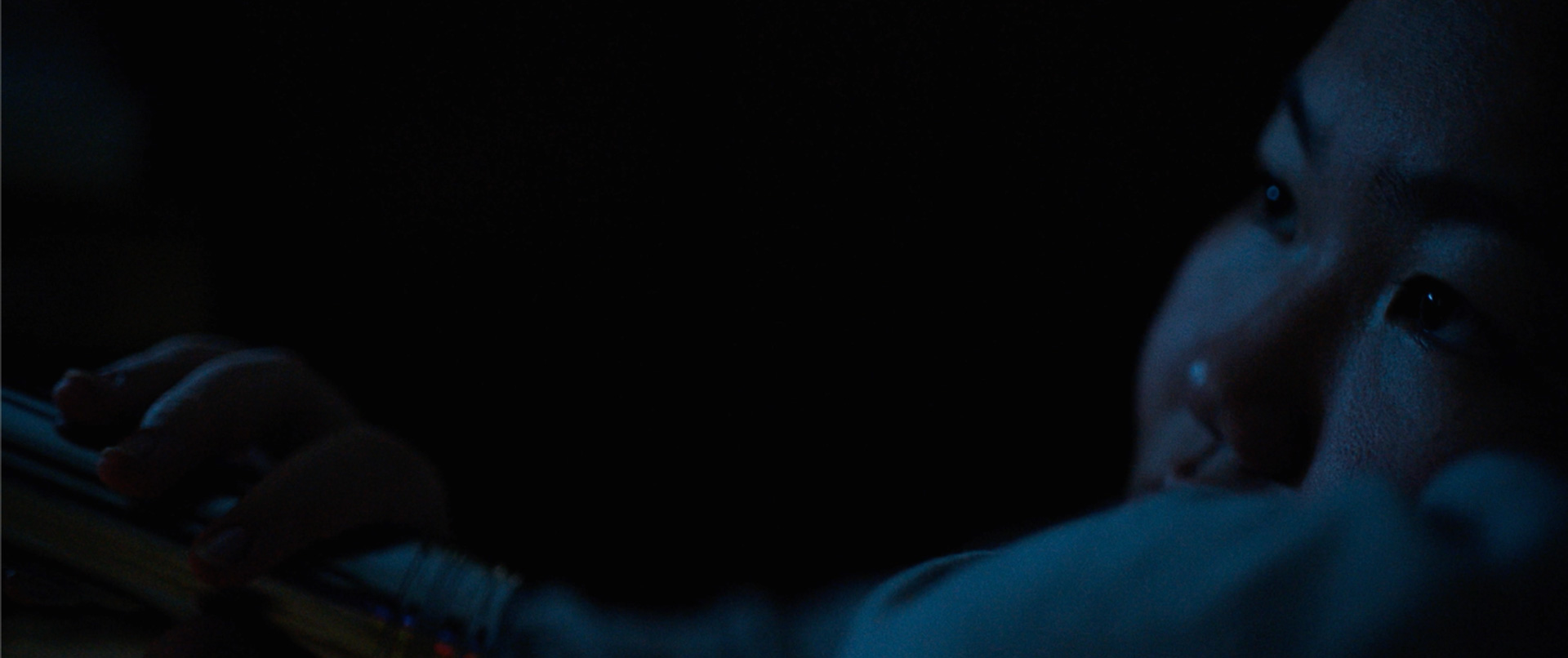
Melissa Uehara, still from “Amarela”, São Paulo, 2023. Courtesy of: MyMama Entertainment.
Art Dialogues would like to extend heartfelt congratulations to the incredible team behind “Amarela” for their remarkable achievements. We are deeply proud to witness such a powerful and groundbreaking project come to life, driven by a shared vision of exploring identity, culture, and artistic expression.
The dedication, passion, and creativity of this team have not only resulted in a stunning cinematic work but have also opened important conversations about the intersection of Brazilian and Asian diasporic experiences. Their journey, marked by collaboration, resilience, and artistic depth, is an inspiring example of the beauty that emerges from confronting cultural complexities and embracing authenticity.
We are honored to celebrate their success and look forward to the many more accomplishments that are sure to follow!

